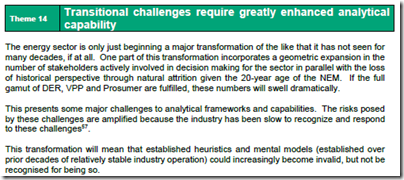Cursory readers of this WattClarity® site could be excused for thinking that we, as a company*, are always looking in the rear-view mirror.
* In this case the ‘we’ means Global-Roam Pty Ltd – who are software providers striving to make complexity understandable in Australia’s energy markets, so you can make better decisions. WattClarity® is one of our products (just happens to be one you can access freely).
That would be an understandable conclusion, for those just interacting with us on WattClarity (especially with the uptick in articles reviewing what’s been happening surrounding the Callide C4 Catastrophe).
However it would not be the truth!
In reality, we’re (internally) investing more time thinking of the future, through things like:
1) Using our GenInsights21 publication (upcoming in Q3) to think through what recent history is telling us about the energy transition road ahead of us; and
2) In particular, focusing on the two big changes that take place for the market in October 2021.
—————-
These two changes:
Change 1 = Five Minute Settlement (5MS) might be garnering a lot of attention (starting on 1st October 2021)
Change 2 = There is also the introduction of the Wholesale Demand Response Mechanism (WDRM – i.e. the ‘Negawatt Dispatch Mechanism’) that begins on Sunday 24th October 2021.
—————-
As we progressively work through the process of making our software ready for these changes (version 9 of ez2view coming soon, for instance) we’ve come by a number of potential snags that could trip people over, if they are not really careful in understanding exactly what is presented in the new/changed information that AEMO will be publishing from the two transition dates above.
These are as follows:
| Number | Description of the Issue |
| Potential Tripwire #1 The ‘invisible’ 5-minute Trading Periods?! |
This is something we’ve been aware of for some time … and which (we believe) is going to be quite important for the market to understand, moving forward (at least, in part, because the short time horizon covered by P5 Predispatch is not being extended). In this coincident article today, I have explored this… |
| Potential Tripwire #2 What does the price forecast in P30 predispatch actually mean? |
Another day, Marcelle Gannon will post some follow-on thoughts about what the Price Forecast delivered in the P30 Predispatch process will actually mean in this new environment. Marcelle’s article ‘P30 Predispatch forecasts after 5-minute settlement–what do they mean?’ was published on Friday 11th June. A couple things to be aware of, and take into account, when using the price forecasts … especially: |
| Potential Tripwire #3 Don’t make this big mistake (from October 2021) in analysing Bidding Behaviour! |
When we completed the GRC2018 a couple years ago, we noted (in Theme 14 of Part 2 of the 180-page Analytical Component) that ‘The Transitional Challenges require greatly enhanced analytical capability’: … and, in doing this, highlighted some past examples of where (it seems that) errors made in the analysis of bidding information have led to a quite different picture being seen than would have been the case without the errors. One of the existing tripwires that has long pre-dated 5MS has been that bids have always been effectively considered by AEMO on a 5-minute basis. Our ez2view software has seen (and shown) bids this way for 10 years or so! — But just as one tripwire disappears, another is added in its place (and potentially one of increasing significance as well). Linton Corbet follows the earlier two articles with another (new) potential snag in the structure of bid data (arising from changes being made to facilitate WDRM). The article was published on the 18th of June. |
Finally, readers should be very clear with respect to the above (and the linked articles).
Clarification #1) These four articles (including this intro) are being published as a general service to all NEM Stakeholders, to (hopefully) reduce the number of people, and times, that these tripwires lead people to draw incorrect conclusions. We’d be greatly appreciative if you could circulate these cautions to all those you know who are NEM Participants, or other interested NEM Stakeholders.
Clarification #2) Nothing in these four articles is intended to be read as any comment on the overall merits* (or not) of implementing these reforms. Our approach is that they are both happening, and that our job is to help our clients make the most of them (and avoid the tripwires!)
* separately, for instance, it’s quite well known that I have already voiced some concerns about what’s being implemented with the WDRM on 5th March 2019 and 21st October 2019 and 24th November 2020 … but that’s a whole other can of worms!



Leave a comment